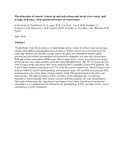| dc.contributor.author | N.M, Kiulia | |
| dc.contributor.author | R, Netshikweta | |
| dc.contributor.author | N.A., page | |
| dc.contributor.author | W.B. Van Zyl2, . Van Z M.M. Kiraithe1, A. Nyachieo1, J.M. Mwenda1,‡, M.B. Taylor2 | |
| dc.contributor.author | M.M., Kiraithe | |
| dc.contributor.author | A., Nyachieo | |
| dc.contributor.author | J.M., Mwenda | |
| dc.contributor.author | M.B, Taylor | |
| dc.date.accessioned | 2013-07-09T11:07:40Z | |
| dc.date.available | 2013-07-09T11:07:40Z | |
| dc.date.issued | 2010 | |
| dc.identifier.citation | Kiulia NM, Netshikweta R, Page NA, Van Zyl WB, Kiraithe MM, Nyachieo A, Mwenda JM, Taylor MB. The detection of enteric viruses in selected urban and rural river water and sewage in Kenya, with special reference to rotaviruses.. Vol. 109.; 2010. J. Appl. Microbiol. 109(3). | en |
| dc.identifier.uri | http://onlinelibrary.wiley.com/doi/10.1111/j.1365-2672.2010.04710.x/abstract?deniedAccessCustomisedMessage=&userIsAuthenticated=false | |
| dc.identifier.uri | http://erepository.uonbi.ac.ke:8080/xmlui/handle/123456789/46691 | |
| dc.description.abstract | Aim: To determine the occurrence of eight human enteric viruses in surface water and sewage samples from different geographical areas in Kenya.
Methods and Results: Enteric viruses were recovered from the water and sewage sources by glass-wool adsorption elution and/or polyethylene glycol/NaCl precipitation and detected by singleplex real-time and conventional PCR and reverse transcriptase-PCR assays. One or more enteric viruses were detected in nearly all sewage and river water samples except the urban Mbagathi River. The VP7 (G types) and the VP4 (P types) of the rotaviruses (RV) were characterized by multiplex nested PCR methods. The G and P types could be determined in 95·5% of the RV strains, respectively. Mixed G types were detected with G12 and G1 predominating, and unusual G types, G5 and G10, were present. P[4] predominated in the urban Karen sewage samples, while P[8] predominated in the urban and rural streams.
Conclusions: The high prevalence of RVs in surface water highlights the importance of assessing the water sources used for domestic purposes for viral contamination.
Significance and Impact of the Study: This study demonstrates the benefit of environmental surveillance as an additional tool to determine the epidemiology of RVs and other enteric viruses circulating in a given community. | en |
| dc.language.iso | en | en |
| dc.publisher | University of Nairobi, | en |
| dc.subject | enteric viruses | en |
| dc.subject | Kenya | en |
| dc.subject | river water | en |
| dc.subject | rotaviruses | en |
| dc.subject | sewage | en |
| dc.subject | wastewater | en |
| dc.title | The detection of enteric viruses in selected urban and rural river water and sewage in Kenya, with special reference to rotaviruses. | en |
| dc.type | Article | en |
| local.publisher | College of Health Sciences, | en |

